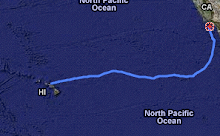A few posts back, we heard about the mini trawl Marcus and Joel fashioned at sea. Like a plankton net, the trawl is a fine, mesh net used to skim the oceans surface, and analyze the collected contents for plastics.
Here, Marcus discusses what they are beginning to find (three guesses, first two don't count) as JUNK skirts the edge of the infamous North Pacific Gyre....
As JUNK is now in the gyre, the notorious plastic soup zone, Marcus and Joel have been on the lookout for debris all along. See here Joel’s marine debris observations, starting from their launch back in June:
Part I
I try to spend several hour each day looking out to sea while listening to my iPod and there is quite a few things to look for, hazards like tanker ships that could run us over or large pieces of floating debris like shipping containers, changes in weather, or interesting and tasty sea-life. And of course plastic debris.
At first, most of the plastic debris I've seen so far was right there in Long Beach's Rainbow Harbor, where we built and launched JUNK. Plastic bags, snack bags, bottles bottle caps, all kinds of packaging, rubber slippers and organic slime. The mouth of the LA river is next to the entrance to Rainbow harbor and the tide seemed to bring a fresh load of rubbish during float. Everyday four or more workers went around with long nets and tried to scoop up the flotsam – an exercise in futility, as “fresh” trash poured down the river and into the harbor daily. On days when the tide brought in lots of debris they brought out the "Trash Boat", with large booms that scoop the trash on board. It didn't seem to work to well though. The water displaced by the hull of the boat would push the plastic rubbish further underwater before the boom could scoop it up. I talked to one of the city workers and they said that the boat can’t pick up items like plastic that have a density close to that of water and float just below the surface.
It made me think...if we cannot clean one little harbor on a budget that can afford four employees and a boat how could we expect to clean up an area the size of the North Pacific Gyre?
Part II
The ocean surrounding the Channel Islands had a lot of observable plastic debris floating on the surface, mostly common items like bottles and bottle caps, fishing floats and plastic bags. I didn't notice much fouling. Fouling is marine growth like algae, barnacles or coral on man-made things in the ocean. Heavy fouling can indicate that a piece of debris has been in the ocean for a long time. Most of the debris I saw around the Channel Islands had very little, suggesting it was litter that had recently washed into the ocean. The presence of a large amount of debris with little fouling and little heavily fouled debris can indicate an area that disperses debris instead of collecting it. I would guess that the floating rubbish from the LA river washes up on local beaches or moves off shore and makes a long voyage around and around in the North Pacific Gyre.
Part III
After leaving the Channel Islands we sailed south staying about 100 miles off the coast of Baja California. South of Isla Guadalupe we started heading west. I spent a good amount of time staring out at sea during that time. We were becalmed several times which makes it easier to observe small photodegraded pieces of plastic that are nearly the same density as sea water and tend to get pushed down the water column when the wind stirs up the water and then raise to the surface when the seas are calm. Yet in spite of being close to land and being becalmed often I didn't see much debris at all. Mostly just palm leaves and kelp, the “good” type of marine debris.
More to come....
Thursday, August 7, 2008
Subscribe to:
Post Comments (Atom)











3 comments:
Again and again, we see those plastic floating in the middle of the huge ocean by viewing your daily clip. This Gyre sucks all the junk from everywhere -- I learn so many thing from you guys. I'm so glad I've found your journey....
sweet, keep it up!
Here in landlocked Colorado, we are watching your adventure too, and spreading the word. Will Boulder ban plastic bags and/or bottles this year? Stay tuned...
Linda
Post a Comment